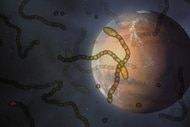Create a free profile to get unlimited access to exclusive videos, sweepstakes, and more!
How NASA Fixed Voyager 1 from 15 Billion Miles Away
This is the most distant repair job in history.
When the crew of SYFY’s The Ark jumped a ship to Proxima centauri (the star next door), they embarked upon the longest journey humanity had ever taken, either personally or through the use of machines. As it stands in the real world, the current deep space record holder is the distant spacecraft Voyager 1. Launched in 1977, it’s presently at a distance of more than 15 billion miles from Earth.
Back in November of 2023, Voyager 1 started sending back nonsense in place of readable data. Now, engineers on Earth have figured out how to get Voyager talking again.
NASA Engineers Got Voyager 1 Talking Again!
Beginning November 14, 2023, the Voyager team at NASA’s Jet Propulsion Laboratory (JPL) started receiving a bunch of binary gibberish from deep space. They confirmed that Voyager was still receiving signals from Earth and otherwise operating normally, but when it tried to talk with us, everything came back garbled. In March of 2024 the team finally figured out the source of the problem.
For More on Voyager
Why Did Voyager 1 Just Start Transmitting Gibberish from Deep Space?
The Life and Eventual Death of Voyager 1 and 2
Voyager 1 is Now Rocking Out to Some Sweet Space Tunes Further Away Than Ever
The twin Voyager spacecraft have onboard computers called the flight data system (FDS) which takes information from the spacecraft’s other systems and health data from the craft itself and bundles it together to send to Earth. One of the chips in the FDS got busted, rendering that portion of the system and the code it housed unusable. Unfortunately, the team on Earth couldn’t replace it from 15 billion miles away so they had to find a remote fix.
To make matters worse, there was no one location in Voyager’s brain large enough to store the stuff on that chip. To work around that, engineers broke the contents into bits and stored them in various places, then they rewrote the associated code so Voyager knew how to use the bypass. Pulling that off was a laborious process in no small part because of the light-speed delay in communicating with Voyager. Every time the team wanted to test something, they had to send a signal and wait 22.5 hours for Voyager to receive it. Then they had to wait another 22.5 hours for Voyager’s answer to come back.
The team at JPL started by fixing the systems related to engineering data. That means Voyager can now tell the folks on Earth how it’s doing. Now, the team is working on implementing the same fix for the parts of Voyager responsible for sending back science data. If everything goes according to plan, Voyager 1 will soon resume sending observations from interstellar space, nearly 50 years after it left Earth.
For more things going wrong in deep space, catch The Ark when it returns for Season 2 on Peacock!































